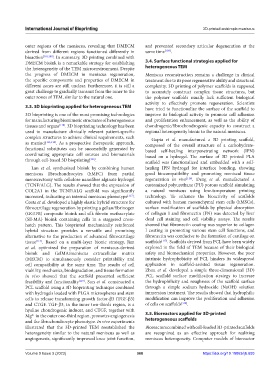Page 376 - IJB-9-3
P. 376
International Journal of Bioprinting 3D-printed anistropic meniscus
outer regions of the meniscus, revealing that DMECM and prevented secondary articular degeneration at the
derived from different regions functioned differently in same time [103] .
bioaction [101,109] . In summary, 3D printing combined with
DMECM bioink is a remarkable strategy for establishing 3.4. Surface functional strategies applied for
the heterogeneity of the TEM microenvironment. Despite heterogeneous TEM
the progress of DMECM in meniscus regeneration, Meniscus reconstruction remains a challenge in clinical
the specific components and properties of DMECM in treatment due to its poor regenerative ability and structural
different zones are still unclear. Furthermore, it is still a complexity. 3D printing of polymer scaffolds is supposed
great challenge to gradually transmit from the inner to the to accurately construct complex tissue structures, but
outer zones of TEM, similar to the natural one. the polymer scaffolds usually lack sufficient biological
activity to effectively promote regeneration. Scientists
3.3. 3D bioprinting applied for heterogeneous TEM have tried to functionalize the surface of the scaffold to
3D bioprinting is one of the most promising technologies improve its biological activity to promote cell adhesion
for manufacturing biomimetic structures of heterogeneous and proliferation enhancement, as well as the ability of
tissues and organs [110] . 3D bioprinting technology has been chondrogenic/fibrochondrogenic capacity to construct a
used to manufacture clinically relevant patient-specific regional heterogeneity bionic to the natural meniscus.
complex structures to achieve clinical requirements, such Gupta et al. manufactured a 3D printing scaffold,
as menisci [111,112] . As a prospective therapeutic approach, composed of the overall structure of a carbohydrate-
functional substitutes can be successfully generated by based self-healing interpenetrating network (IPN)
coordinating appropriate cell sources and biomaterials based on a hydrogel. The surface of 3D printed PLA
through cell-based 3D bioprinting [113] . scaffold was functionalized and embedded with a self-
Lan et al. synthesized bioink by combining human healing IPN hydrogel for interface bonding, showing
meniscus fibrochondrocytes (hMFC) from partial good biocompatibility and promoting meniscal tissue
meniscectomy with cellulose nanofiber alginate hydrogel regeneration in vivo [116] . Deng et al. manufactured a
(TCNF/ALG). The results showed that the expression of customized polyurethane (PU) porous scaffold simulating
COL2A1 in the TCNF/ALG scaffold was significantly a natural meniscus using low-temperature printing
increased, indicating an internal meniscus phenotype [113] . technology. To enhance the bioactivity of scaffolds
Costa et al. developed a highly elastic hybrid structure for cultured with human mesenchymal stem cells (hMSCs),
fibrocartilage regeneration by printing a gellan/fibrinogen surface modification of scaffolds by physical absorption
(GG/FB) composite bioink and silk fibroin methacrylate of collagen I and fibronectin (FN) was detected by live/
(Sil-MA) bioink containing cells in a staggered cross- dead cell staining and cell viability assays. The results
hatch pattern. This bioprinted mechanically reinforced showed that fibronectin coating was superior to collagen
hybrid structure provides a versatile and promising I coating in promoting various stem cell functions, and
alternative to the production of advanced fibrocartilage fibronectin was conducive to the formation of cartilage on
tissue [114] . Based on a multi-layer bionic strategy, Jian scaffolds [117] . Scaffolds derived from PCL have been widely
et al. optimized the preparation of meniscus-derived explored in the field of TEM because of their biological
bioink and GelMA/meniscus extracellular matrix safety and biomechanical properties. However, the poor
(MECM) to simultaneously consider printability and intrinsic hydrophobicity of PCL hinders its widespread
cell compatibility at the same time. The results of cell application in scaffold-assisted tissue regeneration.
viability, mechanics, biodegradation, and tissue formation Zhou et al. developed a simple three-dimensional (3D)
in vivo showed that the scaffold presented sufficient PCL scaffold surface modification strategy to increase
feasibility and functionality [115] . Sun et al. constructed a the hydrophilicity and roughness of the scaffold surface
PCL scaffold using a 3D bioprinting technique combined through a simple sodium hydroxide (NaOH) solution
with hydrogels loaded with PLGA microspheres and stem immersion treatment. The results showed that hydrophilic
cells to release transforming growth factor-β3 (TGF-β3) modification can improve the proliferation and adhesion
and CTGF. TGF-β3, in the inner two-thirds region, is a of cells on scaffolds [118] .
hyaline chondrogenic inducer, and CTGF, together with
2+
Mg in the outer one-third region, promotes angiogenesis 3.5. Bioreactors applied for 3D-printed
and the fibrochondrocyte phenotype. In vivo experiments heterogeneous scaffolds
illustrated that the 3D-printed TEM reestablished the Bioreactors combined with cell-loaded 3D-printed scaffolds
heterogeneity similar to the natural meniscus as well as are recognized as an effective approach for realizing
angiogenesis, significantly improved knee joint function, meniscus heterogeneity. Computer models of bioreactor
Volume 9 Issue 3 (2023) 368 https://doi.org/10.18063/ijb.693

